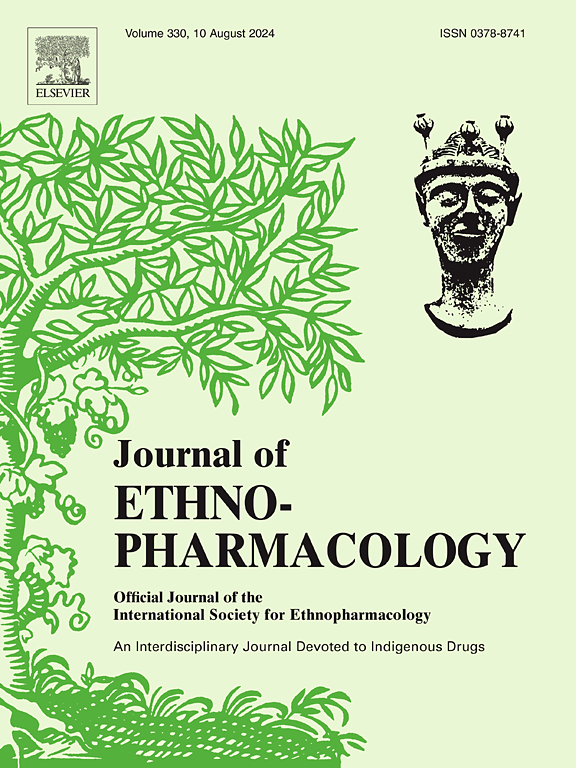Swietenine improved the progression of diabetic nephropathy through inhibiting ferroptosis via activating Akt/GSK-3β/Nrf2 signaling pathway
IF 4.8
2区 医学
Q1 CHEMISTRY, MEDICINAL
引用次数: 0
Abstract
Ethnopharmacological relevance
Swietenia macrophylla King is a traditional medicinal plant extensively utilized in Asia and its pharmacological properties primarily involve antidiabetic, anti-inflammatory, antioxidant, antibacterial, and antitumor effects. Swietenine (Swi), the major bioactive compound presents in the fruits of S. macrophylla, has demonstrated beneficial therapeutic effects on diabetic nephropathy (DN). However, the underlying mechanism through which Swi influences DN remains unclear.
Aim of the study: The current research aims to investigate the effects of Swi on DN and explore its underlying mechanisms associated with ferroptosis, both in vivo and in vitro.
Methods
A model of streptozotocin/high-fat diet (STZ/HFD)-induced Sprague-Dawley (SD) rats was employed to assess the effect of Swi on improving DN and resisting ferroptosis in vivo. Additionally, mouse podocyte cells (MPC-5 cells) were induced by high glucose (HG) and cultured to explore the potential mechanisms of Swi in treating DN in vitro. To further validate the protective effects of Swi, pathway-specific inhibitors were administered to HG-induced MPC-5 cells to confirm the involvement of the Akt/GSK-3β/Nrf2 signaling pathway in the inhibition of ferroptosis. A combination of proteomics, immunohistochemical staining, western blotting, and cell culture techniques was utilized to explore the pharmacological mechanisms of Swi. Furthermore, network pharmacology and molecular docking analyses were conducted to predict the targets of Swi in relation to DN, which were subsequently validated through Western blotting analysis.
Results
Administration of Swi significantly enhanced renal function and ameliorated pathological alterations in DN rats, as well as improved oxidative stress and inhibited ferroptosis. In vitro studies revealed that Swi dramatically improved the cell viability and mitigated oxidative stress, and inhibited ferroptosis via activating the Akt/GSK-3β/Nrf2 signaling pathway in HG-induced MPC-5 cells.
Conclusion
This study demonstrates that Swi improves DN by inhibiting ferroptosis via activating Akt/GSK-3β/Nrf2 signaling pathway for the first time, thereby providing a scientific basis that Swi is expected to be a promising candidate drug for the treatment of DN.
猪藤氨酸通过激活Akt/GSK-3β/Nrf2信号通路抑制铁下垂,改善糖尿病肾病的进展。
民族药理学相关性:大叶甜菊(sweetenia macrophylla King)是亚洲广泛利用的传统药用植物,其药理作用主要包括抗糖尿病、抗炎、抗氧化、抗菌和抗肿瘤作用。猪藤碱(Swi)是巨叶葡萄果实中主要的生物活性化合物,对糖尿病肾病(DN)有良好的治疗作用。然而,Swi影响DN的潜在机制尚不清楚。研究目的:本研究旨在研究Swi对DN的影响,并在体内和体外探讨其与铁下垂相关的潜在机制。方法:采用链脲佐菌素/高脂饮食(STZ/HFD)诱导SD (SD)大鼠模型,观察Swi对DN的改善作用和体内对铁中毒的抵抗作用。此外,通过高糖诱导小鼠足细胞(MPC-5细胞)培养,探讨Swi体外治疗DN的可能机制。为了进一步验证Swi的保护作用,我们将途径特异性抑制剂给予hg诱导的MPC-5细胞,以证实Akt/GSK-3β/Nrf2信号通路参与抑制铁凋亡。结合蛋白质组学、免疫组化染色、western blotting和细胞培养技术探讨Swi的药理机制。此外,通过网络药理学和分子对接分析预测Swi与DN相关的靶点,随后通过Western blotting分析验证。结果:Swi可明显改善DN大鼠肾功能,改善DN大鼠的病理改变,改善DN大鼠的氧化应激,抑制DN大鼠的铁下垂。体外研究表明,Swi通过激活hg诱导的MPC-5细胞Akt/GSK-3β/Nrf2信号通路,显著提高细胞活力,减轻氧化应激,抑制铁凋亡。结论:本研究首次证明Swi通过激活Akt/GSK-3β/Nrf2信号通路抑制铁凋亡,从而改善DN,为Swi有望成为治疗DN的有前景的候选药物提供科学依据。
本文章由计算机程序翻译,如有差异,请以英文原文为准。
求助全文
约1分钟内获得全文
求助全文
来源期刊

Journal of ethnopharmacology
医学-全科医学与补充医学
CiteScore
10.30
自引率
5.60%
发文量
967
审稿时长
77 days
期刊介绍:
The Journal of Ethnopharmacology is dedicated to the exchange of information and understandings about people''s use of plants, fungi, animals, microorganisms and minerals and their biological and pharmacological effects based on the principles established through international conventions. Early people confronted with illness and disease, discovered a wealth of useful therapeutic agents in the plant and animal kingdoms. The empirical knowledge of these medicinal substances and their toxic potential was passed on by oral tradition and sometimes recorded in herbals and other texts on materia medica. Many valuable drugs of today (e.g., atropine, ephedrine, tubocurarine, digoxin, reserpine) came into use through the study of indigenous remedies. Chemists continue to use plant-derived drugs (e.g., morphine, taxol, physostigmine, quinidine, emetine) as prototypes in their attempts to develop more effective and less toxic medicinals.
 求助内容:
求助内容: 应助结果提醒方式:
应助结果提醒方式:


